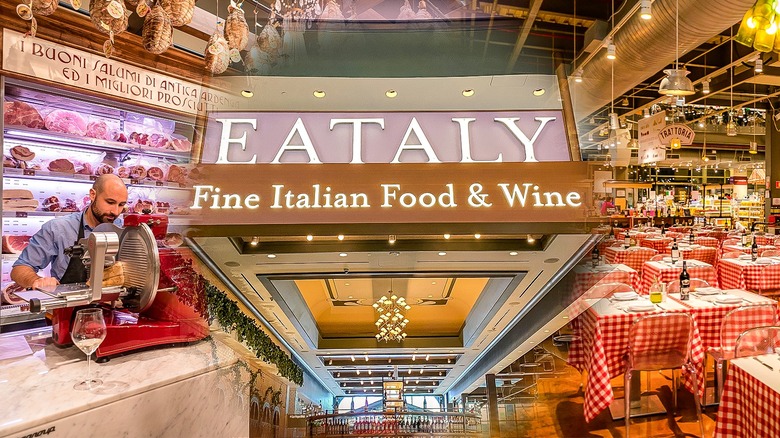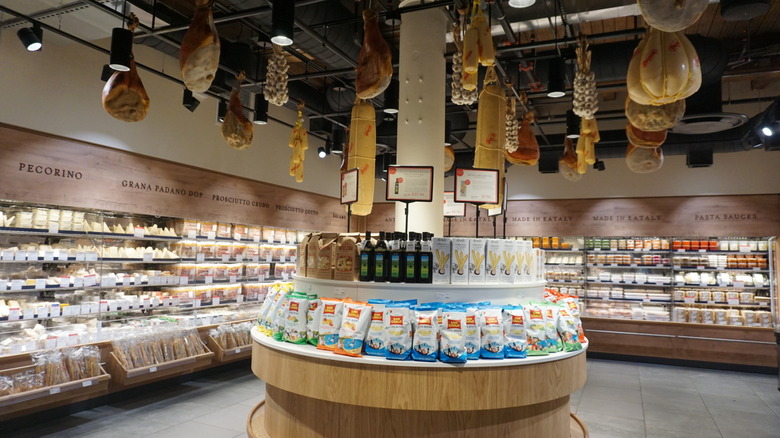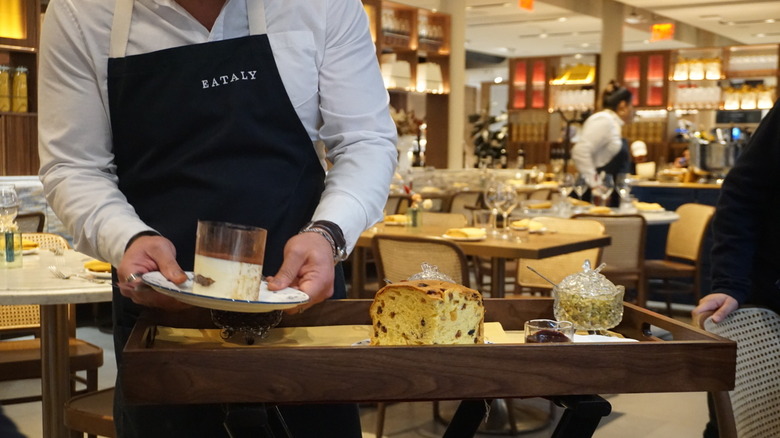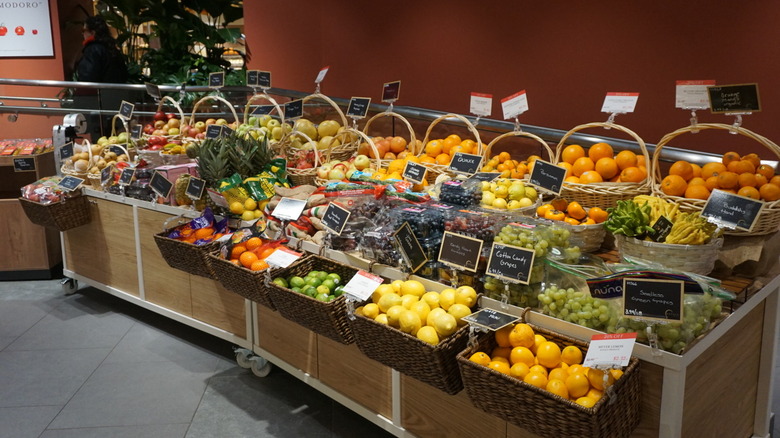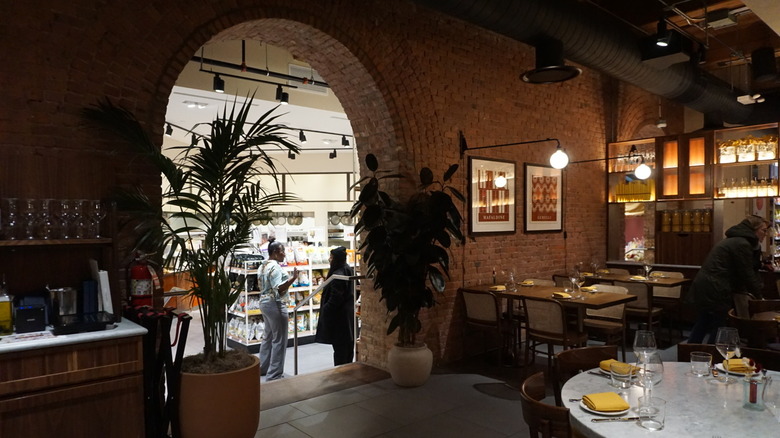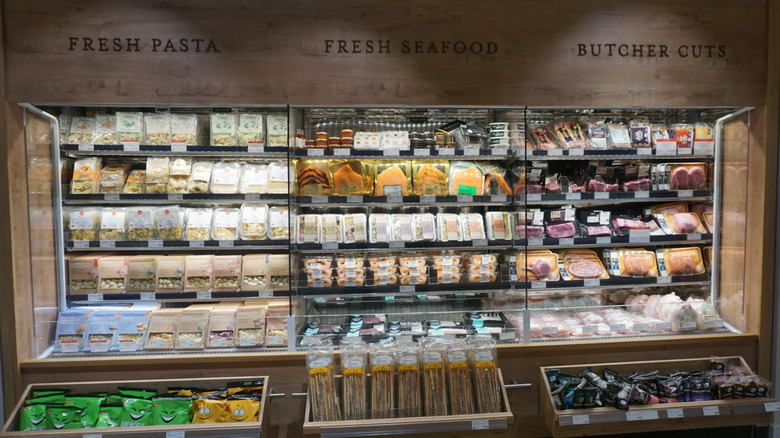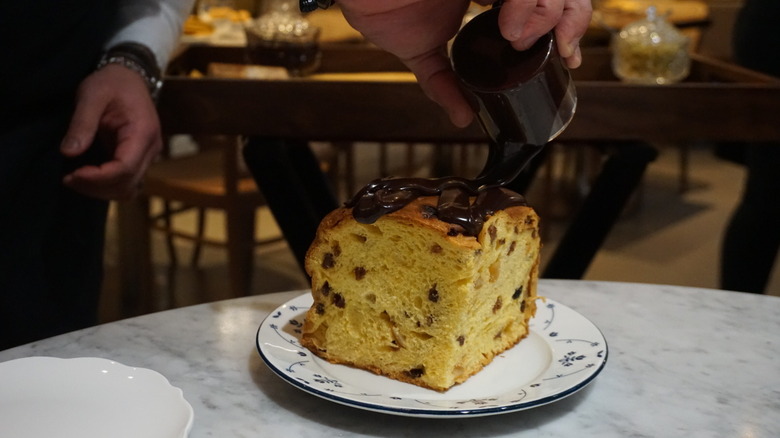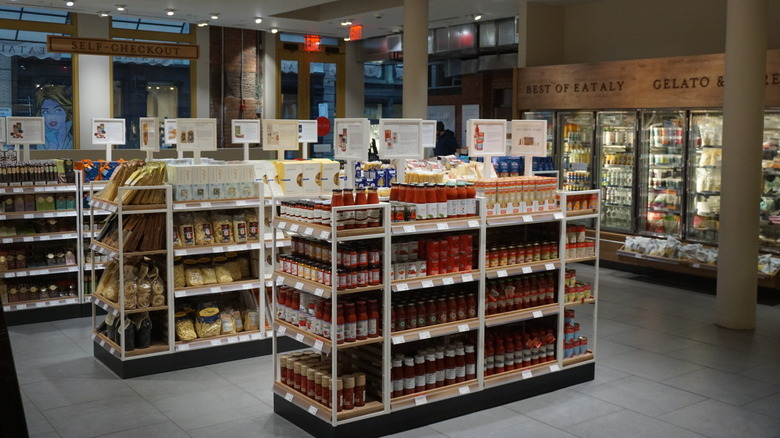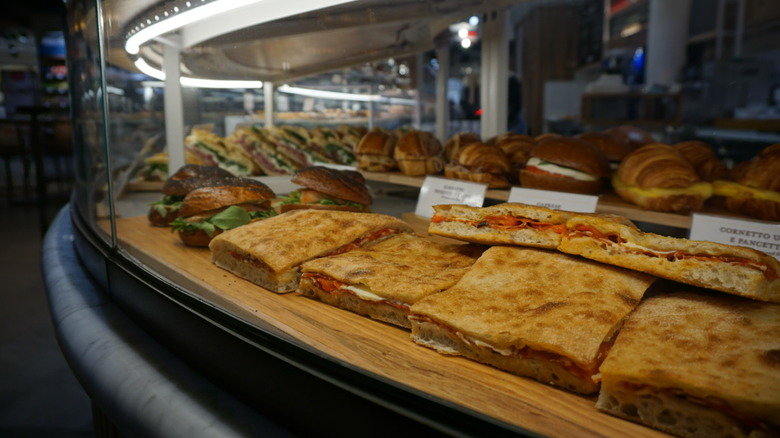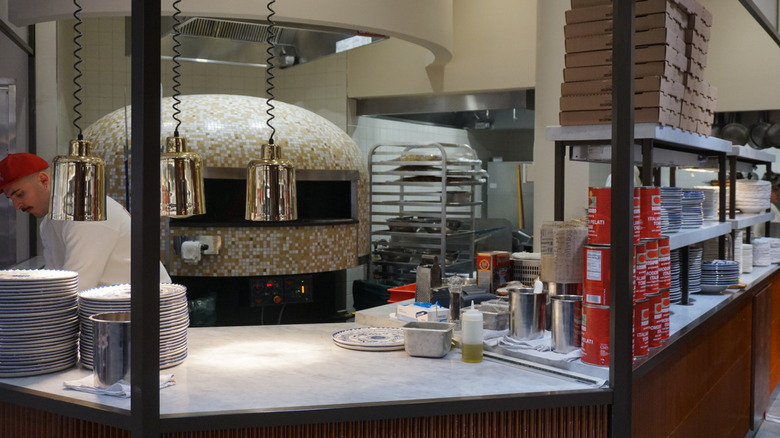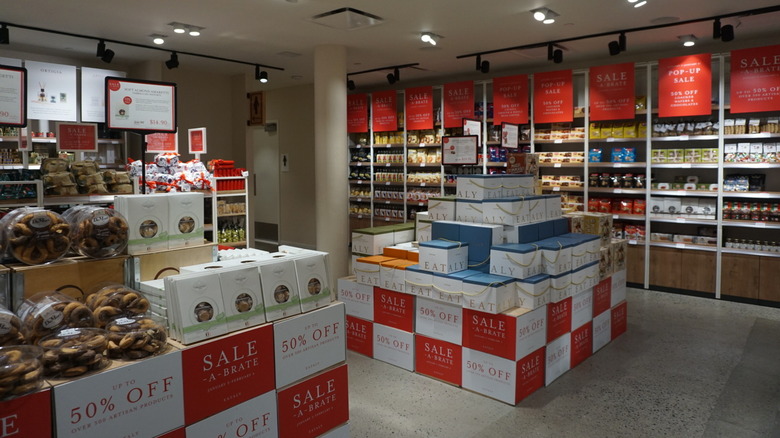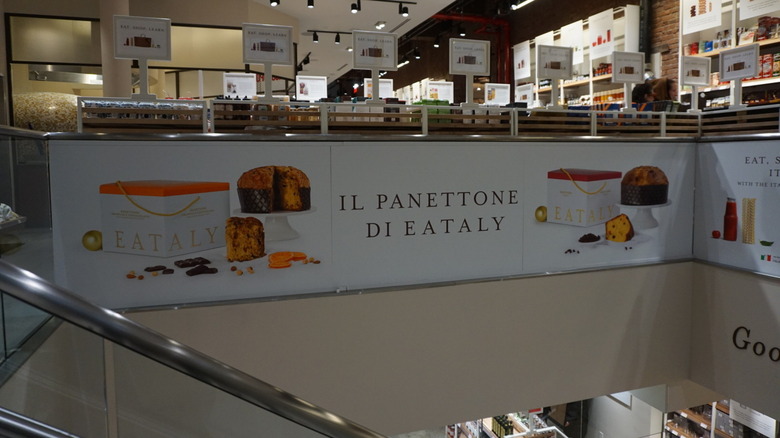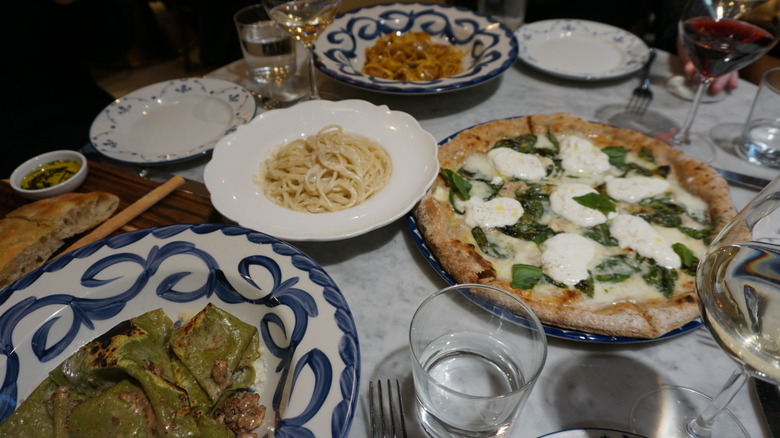Exclusive: All You Need To Know About Eataly, According To Executive Dino Borri
Like getting lost in a good book that twists and winds you through a transformative tale, the experience of Eataly is the same, only with Italian food and heritage and in person. Eataly, if you've not heard of it, is a company/grocery store/restaurant/home base that has a lot to it. Located in many major cities (NYC, Chicago, LA, Boston, London, Toronto, Stockholm, etc.), you can have one of many goals going into Eataly for the first time.
Maybe you've heard whispers of its incredibly authentic and high-quality Italian dinners. Maybe your best friend likes to get their specialty grocery items from there once a month. Or maybe a date has asked you to grab a coffee and a pastry to go for a picnic with them, and you're left wondering how those three occasions could all possibly be happening in the same place. Fear not, as we're going to take you through a journey of the magic and hospitality of Eataly and how you can customize your Eataly experience to be whatever you want it to be. We spoke to the Global Vice President of Eataly Dino Borri, and an Eataly PR representative at the Eataly Soho location and got the scoop on everything Eataly.
Eataly began in Italy
While it's now a totally global company (with a current focus on expansion in North America, but more on that later), Eataly did, in fact, begin in Italy. If you're wondering about how this conglomeration of a business came to be, let's fill you in. It all began in Torino, Italy with founder Oscar Farinetti wanting to create a company based on quality Italian food that you can both eat in the restaurant and shop from in the market, with sustainable practices and accessible information about the food at the center of it all. The first Eataly opened in Torino, Italy in 2007, and it's just grown from there.
There are currently over 40 Eataly locations worldwide, all working to spread the love of authentic Italian food and company. And if you haven't been in an Eataly store since the early days of its inception, a few things have evolved over the years that you should know about.
How the company has evolved since 2007
Borri noted that when Eataly first opened in NYC, it was a pretty novel concept to have your food market and restaurant combined into the same space. "We brought quality of food," Borri adds, "If you remember what was Madison Square Park was totally different. And you know when we opened [Eataly Flatiron] in 2010, Shake Shack opened, we opened... and now it has become a food district. But when we opened, it was just us and a few others."
Along with helping to create the food cultural landscape in major cities, Eataly has also evolved with the world's changes. Not only adept at adjusting to social media and marketing expansions of the 2010s to bring in the millennial and Gen-Z crowds, Eataly always focuses on providing quality and originality to all its customers. Borri noted that they're always eager to bring a new type of pasta, or olive oil, or wine to the store, but that they don't rush the process. Instead, they take the time to make sure every item is quality, while also constantly keeping an eye out for fresh takes on classic Italian foods and traditions.
Recreating the Italian market experience
Getting a bit lost in a large flagship Eataly location is half the fun of things. The first time we wandered into an Eataly, it was the flagship location in NYC, and we had no idea what we were in for. We'd heard about it from an influencer who loved the tiramisu there. We walked in and were immediately amazed at how utterly surrounded by Italian culture you become the second you walk in. People are laughing, shopping, grabbing a sandwich to-go on a lunchbreak, walking in dressed up for one of the fancy restaurants, having a mid-afternoon sweet treat at the gelato bar, and browsing the aisles of dried pasta, olive oil, sauce, and every other Italian grocery item you could imagine for their weekly haul.
Being immersed in the experience is amazing, but if that's something you want to be a little more prepared for, here's what Eataly is going for with its vision (and absolutely achieving, in our opinion). Eataly is meant to make you feel like you're walking through a picturesque street in Italy, with a glass of wine in hand, browsing the various goods and taking it all in. Then you can decide to dine there, grab something to go, have a coffee at the coffee bar, or a combination of them all. Borri explained that the main thing he wants people to get out of Eataly is "To make them have the wish to visit Italy as a country."
Each Eataly location is unique
If you want consistency and familiarity from one Eataly location to another Eataly location, you've got it. But if you want something new and fresh in every Eataly location, somehow, you've also got it. When walking in any Eataly location, there's no question about where you are. Though the color palettes, textures, and details can change from city to city (even with different locations in the same city), walking into an Eataly feels comforting and reliable.
At one of the LA locations, for instance, something more unique to this location is the restaurant Terra (though we will note Terra is also a restaurant also currently at Eataly locations in Silicon Valley, Boston, and Dallas). "In LA, we have another concept that is Terra. Everything is related to the grill," Borri noted. "There is a huge fire, and we grill everything on it." While the wood-fired grill is big at Eataly locations that have the Terra restaurant, so is the wood-burning oven-made pizza. Due to some restrictions in NYC meant to reduce carbon emissions, it's a bit trickier to have a true wood-burning oven for pizza making in the city. But, Eataly's come up with a way to recreate that wood-burning oven taste without the actual oven, so your pizza is just as tasty, though it just took a different journey to get there. Different city restrictions play a part in Eataly dishes but so do local tastes and ingredients (more on that in a bit).
Eataly comes in more than one layout
Eataly Flatiron and Eataly Soho may be located just mere neighborhoods away from each other in NYC, but they are slightly different styles of Eataly. One is what's referred to as a flagship location, and the other is a more neighborhood location. In fact, what counters, restaurants, amount of stock in the grocery section, classes, and popups that are available all depend on how much space that Eataly location has to work with. In train station Eataly locations that are much smaller, you'll find a sized-down version of the bigger Eataly you know and love.
At more medium-sized neighborhood Eataly locations, these are typically secondary or tertiary stores added in a city that already has a flagship location. The neighborhood Eataly stores will typically have a restaurant, a market area, and a to-go food area, just like a flagship, but just on a smaller scale, with more curated products. The third kind of Eataly is the flagship store. This type has everything Eataly you could ever imagine, from multiple restaurants to expansive shopping options to gelato bars, coffee bars, classes to take, and more. "When you have a larger space, you have different restaurants, and you have the counters — meat, fishmonger, cheesemonger," Borri adds. You can also find things like rooftop bars and pop-ups at some flagship locations.
Expect seasonal menu items and more in each restaurant
Now that you know some Eataly locations have more than one restaurant, which restaurant should you pick? Well, there are some determining factors to consider. First, if you're type A, you can go online to Eataly's website and look at the menus for each restaurant and determine what you want. Some restaurants are more centered around pizza and pasta, while others focus more on the extensive wine selection, and others care a lot about the meat entrees. But no matter which restaurant you pick, you'll be getting high-quality, delicious Italian food, that's for sure.
Because Eataly prioritizes working with local vendors and using uber-local ingredients (except for those that can be imported from Italy), each dish will taste slightly different from location to location. Rather than spending the time, energy, and gas to ship specific ingredients across the county, "We care a lot about the sustainability, and, of course, it doesn't make any sense for milk, fish, produce [to be shipped]," Borri notes. Because of this, there are also incredible seasonal menu items at each restaurant at each location, so if you're eyeing up something seasonal like truffle-based pasta, it's smart to get it while the truffles are in season. Things like the beloved cacio e pepe will be available at most restaurants year-round, but again, because of the slight differences in local ingredients, it might even taste a bit different from location to location.
Locals love shopping in the market
Dining in Eataly is a wonderful experience, but so is the grocery shopping. Even at neighborhood Eataly locations, the selection of produce, meats, cheeses, dried goods, and even flowers is plentiful. With items that can be shipped from Italy, the folks at Eataly work to form close relationships with farmers, wine-makers, and food producers all across different regions of Italy to bring the flavors of Italy to, well, everywhere they can. For fresh items like produce, meat, and dairy, Eataly works with local businesses close to each Eataly location to support local and ensure everything is as fresh and organic as possible.
If you live in close proximity to an Eataly store, we would encourage you to check out the market shopping in it. With hundreds of varieties of cheese, olive oil, olives, sauces, pasta, prosciutto, other meats, and so much more, you'll be getting much higher quality ingredients that are available than at most large grocery stores. For instance, at a normal grocery store, you might find one or two different types of Parmigiano Reggiano, but at both the flagship Eataly locations and the neighborhood ones, "Instead of having 20 different types of Parmigiano Reggiano [at a flagship], we have five," Borri commented. But even five types of one specific type of cheese at a neighborhood Eataly location is bountiful compared to the limited selection at major grocery stores.
Eating at Eataly isn't just fine dining
Not up for sitting down at a nice restaurant for dinner, but also don't want to buy your ingredients and make your meal at home? No worries. Eating at Eataly isn't just limited to those two options. Depending on which location you pop into, you can get everything from pre-made (but always freshly made in-house) sandwiches, salads, focaccia, gelato, pizza, pasta, and more. Something we wholly appreciate about Eataly, and even in its grab-and-go section, is the transparency.
For the Eataly Flatiron flagship location in NYC, about the paninis offered there, the website tells you what farm the chickens come from that make up the meat on the sandwiches and what their diet consists of. Everything down to the bread used for the sandwiches is homemade daily, so you can know that what you're putting into your body is quality. Also, at the grab-and-go section in most Eatalys is a coffee bar. Eataly partners with Italian company Lavazza (which actually originated in the same town as Eataly did), and you can find every specialty coffee drink you could think of for a morning pick-me-up.
Learn the Italian tips and tricks in classes
At Eataly, the folks there truly have a wealth of knowledge about all things Italian food. "Of course, we are Italian, and we usually know about one of the three F's: The food, fashion, and furniture, and we chose the food," Borri said. Because of that, Borri added that in the process of opening different Eataly stores in different countries and cities (he's been with Eataly since the early company days of 2008), they quickly discovered that different people have different knowledge bases of Italian food and culture. To the very Italian folks at Eataly, certain foods and customs are normal, and they don't think twice about it. But they then realized early on that just because the world is very familiar with pizza and pasta doesn't mean the world knows about everything else Italian.
So, they started incorporating informational and educational programs and practices into Eataly. Part of that is with the Eataly classes it offers. Offered at flagship locations, there are a wide variety of classes you can take for fun, for date night, for a coworker bonding experience, or get as a gift to a loved one who's always wanted to learn more about Italian cooking. There are pizza-making classes, kid's classes, tiramisu-making classes, cheese and wine pairing classes, and more. Anything you'd ever like to know about Italian food, you can probably learn through a fun and interactive Eataly class.
There's always something new going on with pop-ups
Evolving with the seasons is clearly big at Eataly, from restaurant menu dishes to extra items offered in the market (right now, we're in caviar season), but this also applies to the seasonal pop-ups Eataly has. In December and January, the pop-up was panettone — an Italian bread-like dessert typically served at Christmastime. "Basically, it's very weird for the Italian — or it used to be very weird for the Italian — to eat panettone not during Christmas season," Borri noted. "A long time ago, when I moved here, I say, 'Why don't we bring panettone earlier?' And every Italian said, 'You are crazy.'" So Borri and Eataly compromised by currently offering the panettone during December, yes, but they also extended its holiday shelf-life to January, which definitely made Borri happy. "I would love to eat panettone all year long," Borri gushed.
But with the seasonal pop-ups, currently, it's the yearly Sale-a-Brate, the big sale Eataly puts on in the market and homeware section of its stores through February 4th, where items are up to 50% off (with nationwide shipping available). After that, the theme will transition into Valentine's Day, and from there, different products, events, and more will be centered around the seasonal pop-up of the moment. So, if you have a favorite holiday or Italian celebration, check out the Eataly website when it's going on to see if it's doing anything centered around it (it probably is).
Eataly released its first branded product in 2023
Speaking of the comforting dessert pannettone, Eataly actually decided to launch its first branded product, Il Pannettone Di Eataly, in December 2023. This was a packaged product you could purchase in the market area (though you could also order panettone from the menu at many of the Eataly restaurants, but that's not what we're talking about right now), and it was Eataly's first in-house product. When making the panettone, Eataly worked with producers who typically sell their products to be sold at Eataly stores. "How we can be different with what we did with our panettone was also to select the ingredients we want to have," Borri noted. "We want to have something in each category that is super good with our name on it."
What Borri means by each category is that panettone is only the beginning of the Eataly-branded products. Though it's still in the works, and the other potential products haven't been announced as of yet, Eataly has big dreams to, as Borri said, be in every category in its own grocery store. So chocolate, pasta, pasta sauce, and more are the types of Eataly-branded products Eataly is working toward.
Sustainability and zero-waste goals matter at Eataly
Eataly wants to promote Italy and its delicious food, but not at the expense of the environment. After all, we wouldn't have the delectable Italian food without a healthy planet to grow and make it on. As we mentioned earlier, Eataly has very sustainable practices in all its locations, and it even strives for zero waste. "We don't have warehouses where we stock the food," Borri said. "Everything that we order is coming in the store every day. That means that what you see is coming in fresh." He also added that if a chef is making a dish and runs out of a specific type of cheese, it's no problem, as there are more than 200 kinds of cheese on the market shelf they can replace it with.
In addition to trying to use all the food the company has in stores, sometimes, like every restaurant, you can't predict exactly how many people will eat at the restaurant in a day, so certain items end up not being eaten after the restaurant closes for the night. Eataly's solution to this? "We work with a lot of local food banks and other associations," Borri explained about where the extra food at the end of the night goes instead of a trash can. "There are, unfortunately, some people who are less lucky than us, and we help to feed them."
